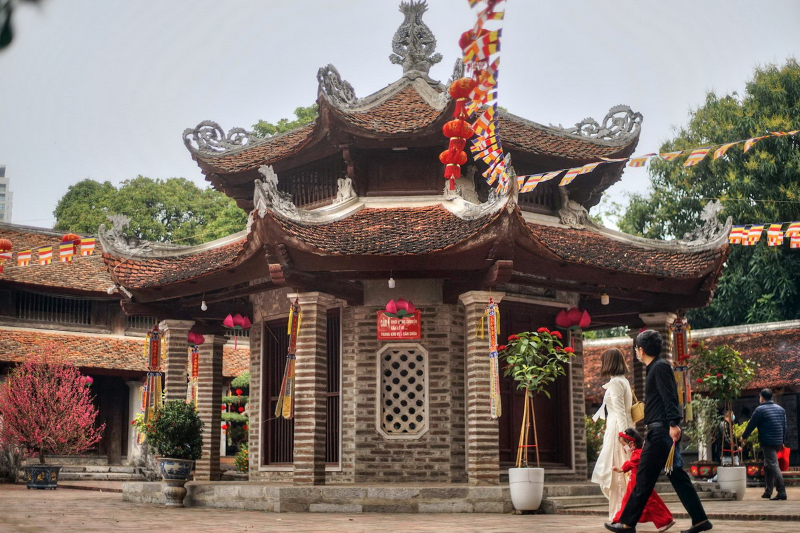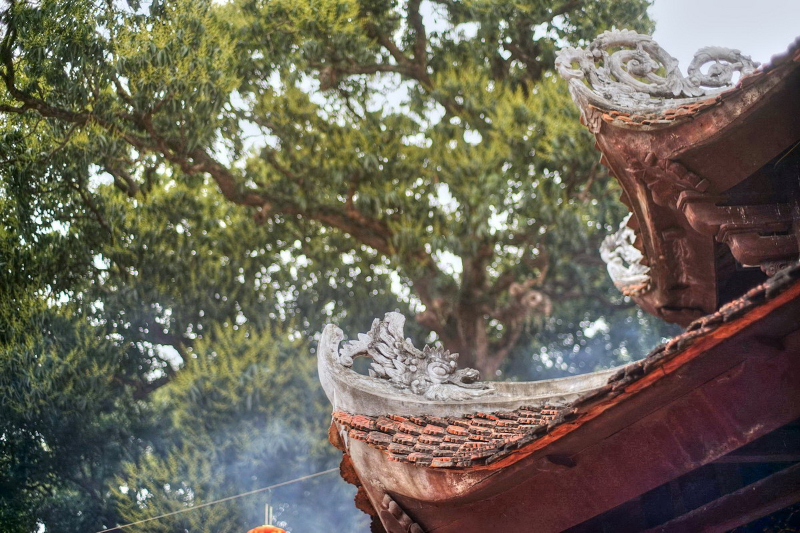Lang Pagoda - Thang Long’s beautiful pagoda of exuberant greenery
With a large architectural complex in an open space, Lang Pagoda, one of the most popular pagodas in Hanoi, was considered the most beautiful pagoda in the midst of exuberant greenery in the west of ancient Thang Long Imperial City.
Ancient Thang Long capital was known as the center of the country’s culture and religion. The land treasuring hundreds of pagodas and temples having been preserved as an important part in the spiritual life of the local people.
Among them, Lang Pagoda is one of the most beautiful.
Fine green architecture
| The Lang Pagoda. Photo: The Buddhist Sangha of Vietnam |
About five kilometers from the city center, Lang Pagoda is located in Chua Lang Street, Dong Da District. The street is named after the pagoda’s, showing its influence.
The Pagoda was built in the 12th century under King Ly Anh Tong’s reign (1138-1175) to worship Buddha. The king father - King Ly Than Tong (who reigned from 1128 to 1138) and Tu Dao Hanh, the most venerable Buddhist monk of that time who was regarded as the forefather of the country’s special art of water puppetry.
In the Ly dynasty (1009-1225), Buddhism flourished and many pagodas were built, such as Tran Quoc, One Pillar, Kim Lien and Lang, which are still well-preserved today. Among them, Lang Pagoda has many distinctive features, making it one of the most popular pagodas in the capital.
| Photo: The Buddhist Sangha of Vietnam |
Lang Pagoda has the typical architecture of Vietnamese pagodas with two long corridors connecting the first and the last compartments to form a rectangular frame surrounding an architectural work in the middle, which is usually the most important part of the pagoda like the worshiping chamber or incense burning place.
The pagoda has a three archway with the main arch consisting of four columns with the architecture similar to the gate in the ancient royal palace. Getting through the gate is the courtyard paved with Bat Trang brick, leading to an octagonal house, the unique part of the pagoda.
Located in the middle of the pagoda, the octagonal house is where the statue of monk Tu Dao Hanh is placed and worshiped. With a two-level roof, the house is also a sophisticated sculpture artwork, featuring four phoenixes dancing on the top and eight dragons flying around the roof representing eight reigns of the Ly dynasty. Inside the chamber, the wall features various paintings depicting different themes.
| Lang Pagoda in the old time. Photo: Thang Long Cultural Heritage Association |
Moreover, the pagoda is a large, harmonious and symmetrical architectural complex with 100 compartments in an airy green space of gardens and old big trees, creating a beautiful tranquil place blended with nature. Therefore, it was regarded as the pagoda with the most beautiful greenery in Thang Long. Today, it is one of the largest pagodas in inner Hanoi.
Rich cultural values
Besides its special architecture, Lang Pagoda also has other treasures with a lot of historical and artistic values.
They are 198 statues, making Lang one of the country’s pagodas with the largest number of worshiping statues. Besides popular Buddhist sculptures, there are two special ones, including one of King Ly Than Tong made of wood sitting on the throne and the other of monk Tu Dao Hanh made of rattan and red lacquer.
| Lang Pagoda in the old time. Photo: Thang Long Cultural Heritage Association |
In addition, there are dozens of horizontal lacquered boards, parallel sentences, and steles. There is a large stele with 1.4 meters high and 0.8 meter wide erected the 17th century with delicate patterns of dragons, phoenix, lotus, fairies, and so on, a masterpiece of stone sculpture of the period.
Particularly, every year, on the 7th day of the third lunar month, Lang Pagoda Festival is organized to show the gratitude to King Ly Than Tong and monk Tu Dao Hanh. It was a lively spring festival of the whole area that attracted people living on the sides of To Lich River nearby to attend. The festival involves ritual ceremonies and traditional games like swinging, wrestling, chess playing, tuong and cheo performances, among others.
Despite current aggressive urbanization, Lang Pagoda still retains its special features, like a hidden beautiful tranquil gem in the green space.



.jpg)










